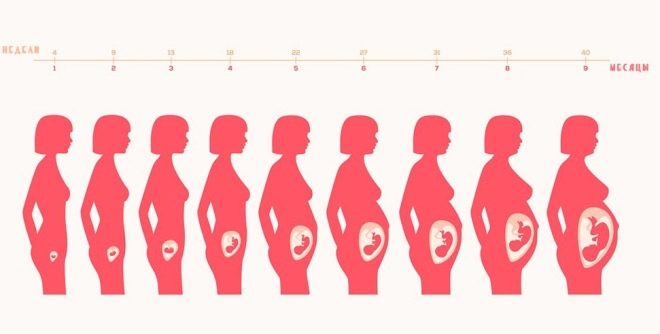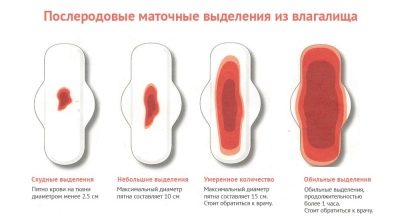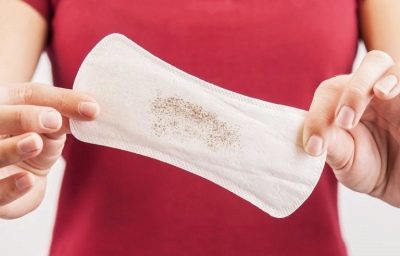How long does the discharge go after cesarean section and what does it depend on?
Discharge after childbirth and cesarean section are very similar. Many women mistakenly call them copious postpartum menses. This definition is incorrect in principle, because the discharge after the operation has a completely different mechanism of occurrence. The question of why they occur after a cesarean section does not often concern women. But the question of when they end, very burning. In this article, we will describe how long the discharge after surgical labor and how to understand that complications have arisen.
What is the reason for the selection?
It does not really matter how exactly a woman has given birth - both after physiological delivery and after operative, so-called lochia (postpartum discharge) emerge from the genitals. They are a sign of the reverse development of the uterus, and this process is rather complicated and long.
During pregnancy, the uterus grows and increases in size, this growth is quite intense. As a result, a small female reproductive organ, whose weight does not exceed 50-70 grams, increases by the time of the birth of the baby more than 500 times. Since the uterus is a muscular organ, its smooth musculature is stretched, due to which such an impressive increase occurs.
After delivery, it should be reduced to its former size. But this does not happen at once. Both after childbirth and after cesarean in the first hours, the uterus remains large, but already has an elongated shape and strongly resembles a deflated ball. Contractions of the uterus contribute to the selection of its internal contents, that is, lohii.
The placenta, which provided nutritional and protective functions for the child, is separated from the wall of the uterus, to which she has managed to adhere tightly with a network of blood vessels for nine months. During childbirth, the “baby seat” is born itself, and during operative labor, the surgeon extracts it after the baby is taken out and the umbilical cord is cut off.
And in fact, and in another case, the network of vessels, which has already become a link between the female body and the baby, is broken. Bleeding after childbirth is associated with this. For caesarean section, the situation is further complicated by the presence of a surgical incision on the wall of the uterus. The incision is a wound that is additionally bloody.
This determines the amount and color of discharge after cesarean section. They differ from ordinary postpartum. After cesarean, lochia is more abundant, and more blood clots may be present. From time to time in the first few days of lochia will increase, this is due to periods of active contraction of the uterus. A woman will be given cutting drugs, because without them, the uterus with the scar will involution more slowly.
The discharge in the maternity hospital is closely monitored by the medical staff, since the nature of the lohii can tell a doctor a lot. At home, after discharge, to observe the discharge of the woman to be on their own. It is very important that you can pay attention in time to possible complications, if any.
Duration is normal
In the first 8-10 hours after the operation, the woman should observe strict bed rest, after that, she should definitely get up, sit down, start walking so that the lochia stagnation does not occur. Abundant blood discharge usually lasts no more than five days.At the end of the first day, the wound edges in the uterus begin to stick together, fibrin filaments help to stop the bleeding at the place of attachment of the placenta. Therefore, the next day, blood clots appear in the discharge. He should not frighten the new mother. They mean that hemostasis is normal, and the processes of blood coagulation and rejection of blood clots in the future proceed correctly.
When the uterus begins to contract, discharge with clots increases. In order for a woman not to feel acute pain, in the first three days she is given not only reducing drugs, but also painkillers. By the fifth day, the secretions change the consistency and composition. Now, pure bloody lochia is replaced by discharge with an increased serum serum content. On a gasket, it may look like a slimy ichor.
After a week, the secretions become even more mucous - the cervix begins to produce a large amount of cervical mucus as the process of repairing the endometrium begins (the inner layer of the female reproductive organ). At about the same time, in the secretions of a woman, brown spots can be found, resembling small worms in their appearance. These are the tips of a surgical suture that did not directly enter the tissues of the uterus, and therefore, as the inner scar heals, they are rejected and brought out by the female body.
4 weeks after surgery, the number of lochia decreases significantly, some may have a brownish daub. Normal are also considered moderate in volume and homogeneous in consistency of yellowish color without a strong and unpleasant odor. By the 8th week after the operation, the discharge becomes transparent, gradually they return to their normal state.
It is believed that the normal duration of the continuation of the discharge after cesarean section is 2 months, but shifts in terms of 2 weeks in one direction or another are acceptable.
Deviations
The cesarean section itself is always associated with the risks of possible early or late complications, moreover, it is a gross intervention in the order of things established by nature, and therefore the burden on the female body during the recovery period is enormous. While in the maternity hospital, early complications usually become noticeable, which are manifested by abundant lochiae, bleeding due to impaired hemostasis of the woman, due to injury of the vascular bundle during the dissection, as well as fever and discoloration and odor of secretions during infection of the wound or cavity uterus.
If the uterus does not contract well enough or does not contract, the bleeding is long and uniform, it does not increase or stop. Sometimes the discharge stops suddenly after a few days. Such situations require immediate medical assistance, and she will be provided to the puerperal. After discharge home responsibility for the control of discharge falls entirely on the shoulders of women. What situations should you pay special attention to? For any that do not fit into the framework of the norm. Here are just a few reasons to visit a doctor without delay:
- bleeding stopped, but after a few days began again, they are quite abundant;
- 10-12 days after surgery, blood clots reappear;
- high body temperature or subfebrile temperature is maintained for several days;
- there was very little discharge in the first days or they completely stopped within 1-2 weeks after surgery;
- substance of green, gray, brown, black color with an unpleasant odor is separated from the vagina;
- Lochia has been going for more than 10 weeks and does not end;
- in the discharge, the woman notices flaky inclusions, the discharge has become very thick, itchy crotch;
- there is severe pain in the abdomen;
- blood or other discharges come not only from the genitals, but also from the area of the external suture on the abdomen.
Pink mucous membranes or watery discharge a couple of weeks after the operation and later may speak about the difficult healing of the inner scar. This happens with autoimmune rejection by the woman’s body of suture material used by surgeons, as well as with early sex life after operation. Saturated yellow and green discharge at any time after surgery is a sign of an obvious infection, most likely, purulent. Usually, their body temperature rises.
Watery discharge almost without color and rather abundant can be a diverting transudate in violation of the blood supply to the uterus, and thick white flakes with flakes can also indicate imbalance in the microflora of the vagina and thrush that manifests after surgery. In all these cases, a visit to the doctor is obligatory. Self-medication is unacceptable.
Tips
Here are some important tips for women who have given birth.
- In the maternity hospital for the first three days, use only sterile hospital bedplates. No purchased pads, because they do not guarantee that the pathogens will not enter the vagina.
- When washing in the maternity hospital and after discharge, water should be avoided in the vagina, as this increases the likelihood of infection. Also, you can not douche.
- Gaskets in the separation of lochia after cesarean section need to be changed more often than during normal periods. Bedplates in the hospital - every three hours, sanitary pads at home - every 2-3 hours.
- Tampons instead of gaskets use is strictly prohibited.
- Sexual life can only live after the discharge in the absence of other complications, that is, no earlier than 2 months after surgery.
- It is forbidden to lift weights above 3-4 kilograms, squat, jump, fall. If such actions were nevertheless committed, and then the discharge intensified or their character changed, you should immediately consult a doctor.
Reviews
Exchanging experience on the Internet, many women forget that they had an individual pregnancy, unlike others, childbirth also had its own characteristics. Therefore, the recovery process after cesarean section can not proceed equally in all. The above norms are conditional and indicate the order of changes rather than clear deadlines. Nevertheless, women continue to ask each other how long the discharge lasted, but they receive completely different answers.
Most women claim that the discharge stopped after 6-7 weeks. There are those who have stopped 30 days after surgery. Abundant discharge usually does not last long, but here the scanty and obscene can annoy for a long time. Experienced moms advise with such scanty lochia drink more fluid. This, they say, helps faster discharge of residues.
On the restoration after cesarean section, see the following video.

























